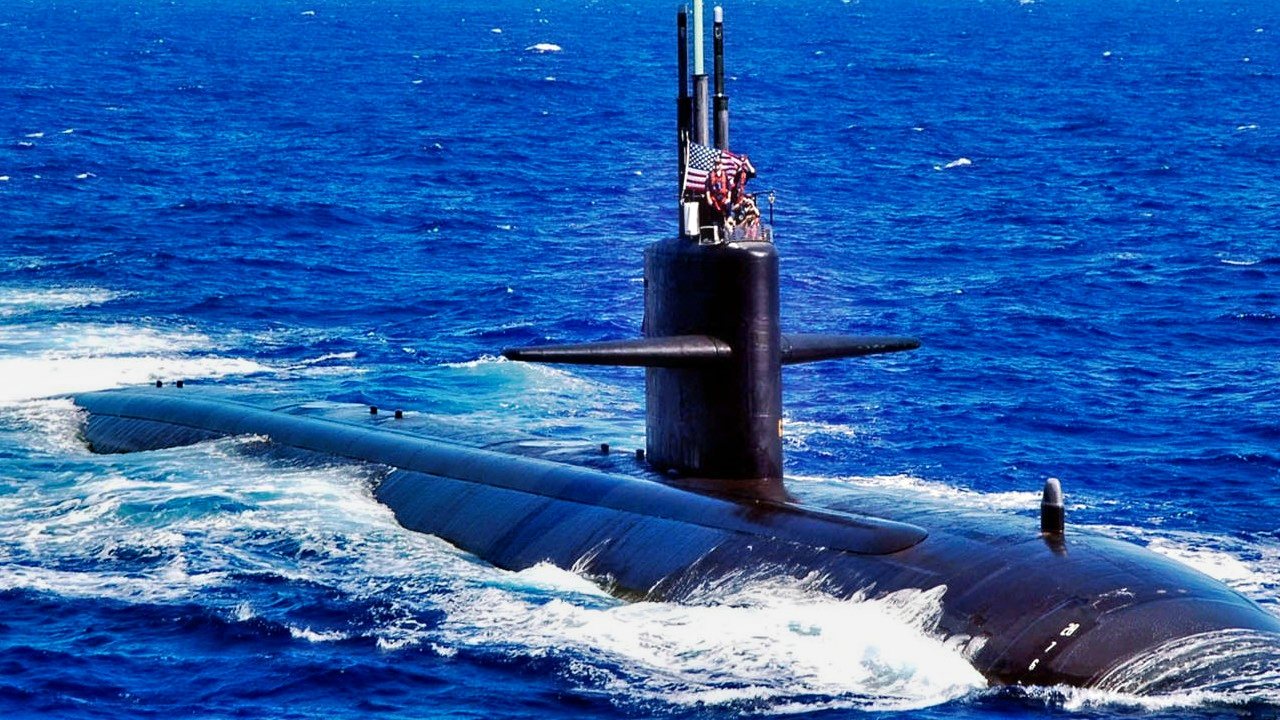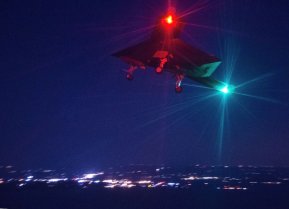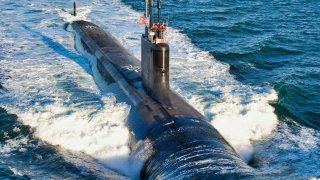Time to Reinvent the U.S. Navy's Submarine Force to Fight China
The age of undersea exceptionalism is drawing to a close in naval warfare. Get used to it, submariners, and get ready. That’s the glum but bracing message from Bryan Clark and Timothy Walton, two fellows over at the Hudson Institute. Their report “Fighting into the Bastions” is nothing less than a call for a revolution in subsurface operations. It’s a message that U.S. Navy officialdom and its political masters must heed.
The age of undersea exceptionalism is drawing to a close in naval warfare. Get used to it, submariners, and get ready. That’s the glum but bracing message from Bryan Clark and Timothy Walton, two fellows over at the Hudson Institute. Their report “Fighting into the Bastions” is nothing less than a call for a revolution in subsurface operations. It’s a message that U.S. Navy officialdom and its political masters must heed.
Read the whole thing.
Retired submariner Clark has been warning for years now that a revolution in undersea affairs is on its way by virtue of advances in technology and antisubmarine tactics. Back in 2015, for instance, he ran a report over at the Center for Strategic and Budgetary Assessments (CSBA) contending that the world’s oceans and seas could become transparent to advanced sensors and processing methods. Submariners could find their world turned upside down soon and suddenly.
For him this amounted to a new age in undersea affairs. No longer would submariners enjoy their seemingly everlasting advantage of being able to take advantage of the nature of water and hydrographic conditions—temperature, salinity, pressure—to hide from hostile subs, surface warships, and aircraft.
Along with submarines’ invisibility cloak the U.S. Navy would, to mix metaphors, lose an ace on which it has relied since U.S. Pacific Fleet subs took to the depths starting in 1941 to pummel imperial Japanese merchant shipping. Clark’s 2015 report set loose a furor, chiefly on scientific grounds. Many objected that seawater has a way of defying efforts to detect, track, and target submerged craft. The coauthors stop short of repeating the claim about transparent seas in the new report.
They don’t really need to. Instead they dispense details about looming problems and recommend potential solutions. This is compelling.
Let me take the liberty of reframing what they say in strategic terms. In effect they maintain that potential foes, China in particular, have absorbed a basic strategic truth—that you may not need to roam around searching colossal volumes of saltwater for enemy subs. What you need to do is defeat enemy subs. That means keeping them from accomplishing goals assigned to them that senior People’s Liberation Army (PLA) naval and military commanders deem unacceptable. Oftentimes confounding them means keeping them out of geographic space Beijing deems important.
In other words, defeating U.S. submarines need not involve their destruction. In a crucial sense antisubmarine warfare resembles counterinsurgent warfare. Properly understood, counterinsurgent strategy aims to protect the populace from insurgents who prey on them for supplies, recruits, and political support. Few insurgencies thrive without such support. Starving an insurgency of invaluable resources demands a strategically defensive posture, and it implies that counterinsurgent forces should take up residence among the populace and more or less stay there on sentry duty. Chasing insurgent units around the hinterland might be desirable given adequate land-warfare resources, but killing insurgents is not the point of counterinsurgent strategy.
Shielding villagers from insurgent depredations is.
The same goes for subs. Think about the battles of the Atlantic during the world wars. It was sometimes possible to find and sink German U-boats in the empty vastness of the Atlantic Ocean. Back then diesel boats were basically surface warships that could submerge briefly for battle. They had to surface or snorkel frequently and could be sighted, especially from aloft, when on or near the surface. Indiscipline at using the radio-frequency spectrum could expose them to triangulation and targeting. Etc.
It was desirable, then, to locate and attack U-boats before they came in contact with Allied convoys. Doing so would prevent raiders from ever targeting their prey. But that wasn’t the paramount goal. Protecting transports and cargo vessels carrying vital manpower and war matériel was. If ships and their freight got through, helping power the war effort in Europe, the antisubmarine effort had accomplished its goal—even if sub hunters bagged precisely zero U-boats.
So effective convoy escorts stayed with ships entrusted to them, engaging U-boats only when they came within weapons reach to launch torpedo attacks. Destroyer and corvette crews that fended off attack defeated the U-boats’ purpose, regardless of whether their depth charges or gunfire sent the assailants plunging to Davy Jones’ locker. They achieved strategically defensive aims.
Similarly, contemporary PLA commanders have realized they need not scour the Pacific depths for U.S. nuclear-powered attack submarines (SSNs) to defeat them. To carry out their missions, U.S. SSNs have to approach what PLA commanders want to protect, in this case the fortified “bastions” the PLA Navy has created in semi-enclosed waters such as the South China Sea. Much as the Soviet Navy sought to do during the Cold War, the PLA Navy is trying to harness geography, naval forces, and shore-based anti-access weaponry to erect a shelter where nuclear-powered ballistic-missile submarines can conduct deterrent patrols without undue fear of assault. Making the South China Sea a no-go zone would also help Beijing make good on its claim to sovereignty over that expanse.

Keeping hostile boats out of the bastions would fulfill the PLA’s strategically defensive goals vis-à-vis the U.S. submarine fleet, much as successful convoy escorts and counterinsurgents fulfill their goals by protecting what matters rather than killing foes. Recognizing this, as Clark and Walton note, Chinese defenders have strewn the bastions with an array of acoustic and non-acoustic sensors and augmented these sensor networks with “aircraft and ships capable of pouncing on contacts or deploying dense mine barriers.”
So that’s the strategic outlook confronting undersea warfare in the Western Pacific. Access denial has dived underwater to nullify America’s asymmetric advantage.
Now, the coauthors softpedal a critical if not decisive aspect of the impending revolution in undersea combat. Namely, the cultural aspect. It’s one thing to fashion newfangled technologies and tactics, another thing altogether to get an institution steeped since its founding in an utterly different way of doing things to accept them—let alone make itself adept in them. Slighting the revolution’s human dimension would constitute a grave mistake.
Not only do Clark and Walton foretell a reversal of the balance between hiders and finders, they urge submarine designers, builders, and commanders to embrace the use of noise as an asset to help them approach and penetrate nautical bastions. Submariners shouldn’t abandon stealth, a passive approach that mainly connotes quieting machinery and hulls. But they should acknowledge that future operations will hinge on deploying active as well as passive measures. They must expand their portfolio.
Sound, that is, will come to be an ally to be exploited as well as an enemy to be suppressed. Operating in concert with offboard unmanned vehicles, subs could deliberately increase the ambient noise level to mask their presence. They could transmit the same acoustic signature from multiple locations to present antisubmarine forces a range of decoy targets to prosecute. They could transmit false sound signatures to disguise the nature of the U.S. presence. They could scatter weapons around the deep and fire them remotely to conceal the sub’s whereabouts. And on and on.
Experimentation will reveal the limits of the possible.
In other words, future submarine operations will come to resemble air combat in important respects despite radical differences between the operating mediums. Air forces go to elaborate lengths to suppress enemy air defenses as well as manned aircraft. Once they rule the sky they can carry out important missions. Clark and Walton foresee similar dynamics in the subsurface arena. In fact, they open their executive summary and close out their report by drawing the comparison to the wild blue and beseeching submariners to learn from aviators. This is a likeness I’ve drawn from time to time in my own writings, thanks in no small part to the catalyst applied by Clark’s 2015 CSBA report.
Think about it. No amount of inventive shaping and coatings renders an aircraft entirely invisible to radar, let alone to thermal sensors and other potential giveaways of a plane’s location. That being the case, aviators supplement passive, imperfect stealth with active measures such as electronic warfare, which employs the electromagnetic spectrum to jam or fool hostile air-defense networks. Electronic attack is the aerial counterpart to the tactical and operational use of sound in the undersea realm.
But active defenses have been etched on aviation culture for decades, whereas they contravene everything undersea warriors have practiced for over a century. What Clark and Walton have in mind for the submarine force is a cultural as much as a technical and tactical revolution. You do not transform an ethos overnight or on command.
The coauthors seem to realize this. In passing they mention that what they prescribe will set in motion a paradigm shift within the submarine force. That’s true, but think about the gravity of what they’re saying. A paradigm shift is a difficult, messy process at the best of times. The reigning paradigm of submarine operations will have defenders, most likely concentrated among senior commanders who have spent their careers in what, after all, styles itself as the silent service. In other words, the officers who wield the greatest authority over the service’s future are the most likely true believers in the old paradigm. It’s by no means assured that Young Turks in the service will get their way in the face of entrenched resistance from above in an operationally relevant timeframe.


